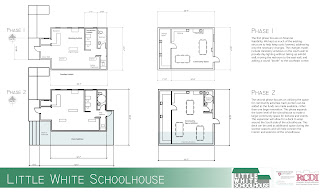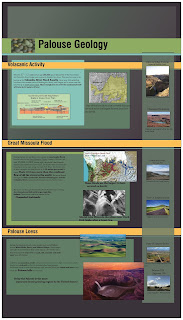This past semester we had the opportunity to work with the community of Valley, WA to propose design ideas for the adaptive reuse of their original schoolhouse to a local museum. We began the process with an all day workshop, meeting with about twenty community members to discuss the needs and desires of the space. While there were many opinions, this made for a great learning experience. Our design needed to please many people, rather than one or two clientele. For our design our focus was to phase out the project. There were so many great ideas that would be hard to implement immediately due to time or budget. The first phase addresses a quick installation and minimal budget. The second phase focuses more on ideas that can be installed individually as the budget allows. This phase also address the need for a community gathering space. Through our design we allow the opportunity for the Little White Schoolhouse to expand and grow as the community needs change.
Thursday, April 25, 2013
Tuesday, February 19, 2013
Webster Geology Museum
This collaborative project was a very new experience for me. Working with 8 other designers was both a challenge and a great learning experience. Through this I learned some very valuable skills. Collaborating with other designers is part of the everyday design world so learning how to work with 9 different design perspectives was a very positive experience. I learned how to communicate my ideas as well as how to listen and understand other's ideas as well. Because of our success collaborating, my partners and I designed a very strong space using the resources the School of Environment and Department of Physics already had available.
Through the process there were multiple challenges including unknown specifics as to regulations and wants and needs of the School. Our group adapted well to these changes. While designing we used trial and error to find the best methods to design. At various points in the process the entire group worked together, worked individually, and worked in smaller groups to complete the project. We found that breaking into smaller groups of 1-3 people, then meeting as a whole group as the work was completed helped get the work done more efficiently. The extensive use of communication helped make sure everyone's voices and opinions were heard.
I found throughout the project that my communication skills were a strength of mine that I was able to develop even more, however my leadership skills were both a strength and weakness. While I am a strong leader, there were times I struggled to step down and let others take the lead. Through the course of the project however, this became easier to do. Our group meetings were especially helpful for learning when to take a leadership role and when to let other's step up in the position.
The poster below is one of 7 case layouts our group designed. It is a great example of our collaborative design. We each individually researched a topic to be displayed in the case, my topic being the geology of the Palouse. Once the research was completed we each individually made posters for our topic. As a group we chose characteristics we all liked to further develop. I partnered with another group member to create a template outline for each member to input their individual research into. After this stage another group member created a cohesive design for all 7 posters. The process really shows how our grouped worked together to create a collaborative design.
Subscribe to:
Posts (Atom)




